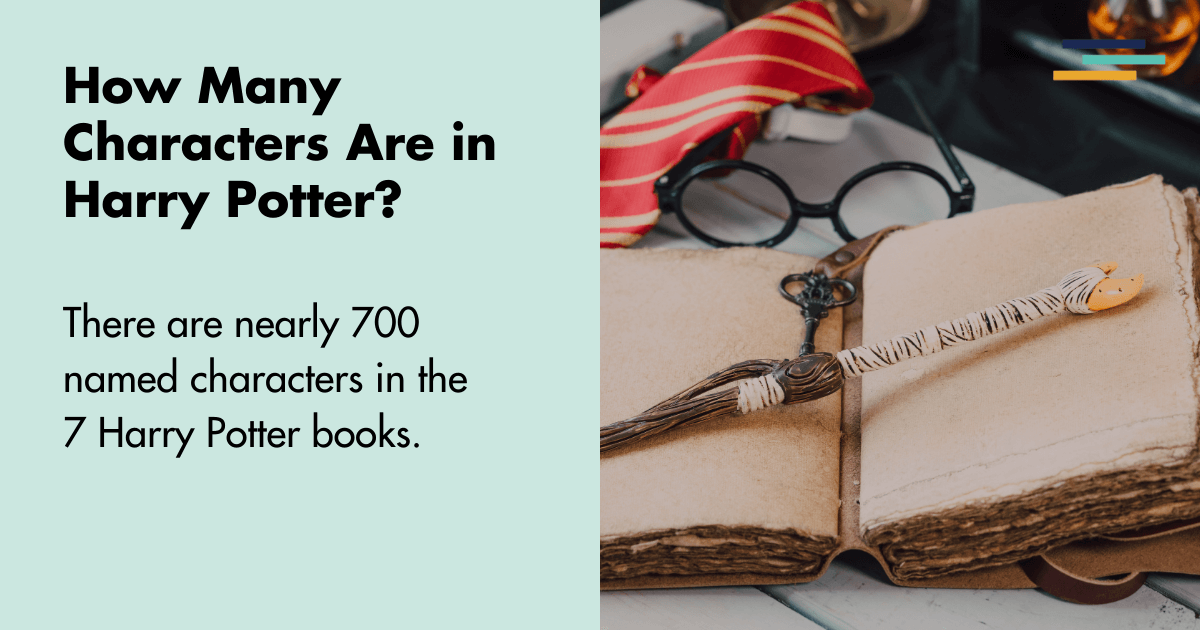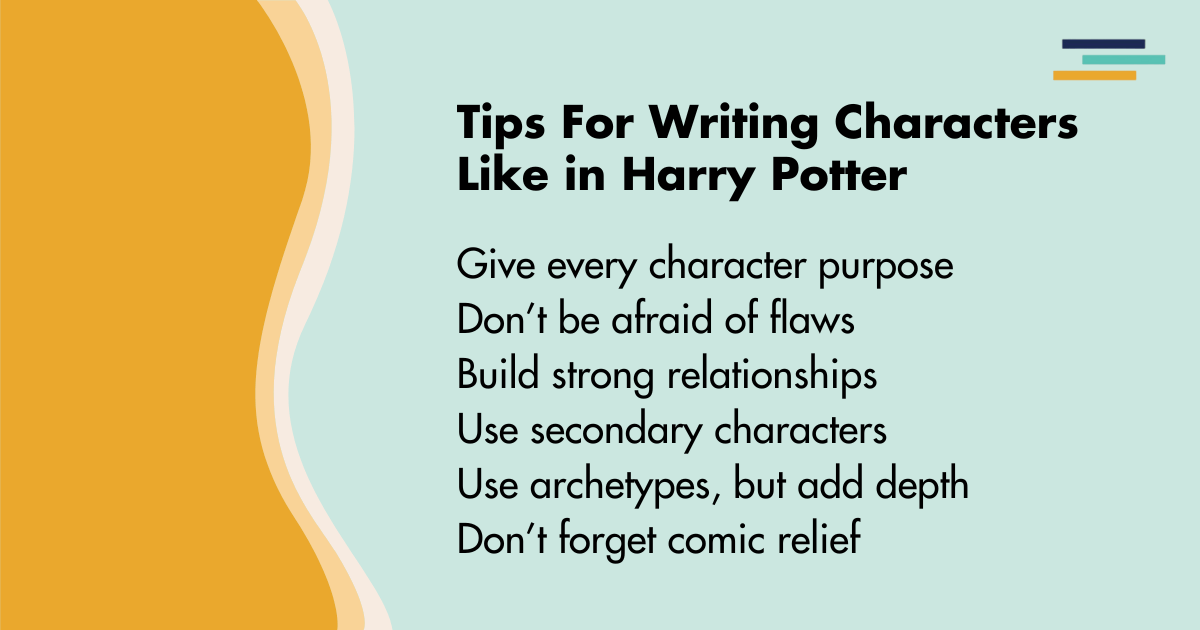
The Harry Potter series isn’t just beloved for its spellbinding world-building and thrilling adventures, but also for its unforgettable characters. Whether they’re witches, wizards, or muggles, these characters each play a crucial role in making the Wizarding World so enchanting.
From comic relief to tragic heroes, every character archetype serves a purpose that helps to drive the narrative forward.
If you’re trying to create fantasy characters that resonate like those in Harry Potter, we’ve got a guide to help you understand how each character type functions within the story.
How Many Characters Are in Harry Potter?
There are nearly 700 named characters in the Harry Potter universe, but don’t worry…
You don’t have to memorize all of them.
We can group the key characters that drive the story into different archetypes that help make the series dynamic and relatable.
These characters serve specific narrative functions that shape the story, and we’ll break down some of the most significant ones below.

Top 10 Harry Potter Characters
Let’s dive into the top Harry Potter characters, each one serving as a different character archetype to help writers understand how to craft characters with similar roles in their own stories.
Harry Potter, The Hero
The classic hero archetype, Harry, is the “Chosen One” who must face monumental challenges and grow into his destiny.
Throughout the series, Harry embodies the reluctant hero. He didn’t ask for the role, but he takes it on, driven by his moral compass and desire to protect others. If you’re writing a hero, remember to give them strengths, but also flaws, because perfection is just boring.
Hermione Granger, The Intellectual
Hermione is the brainiac of the trio, representing the “Mentor” or “Sage” archetype with a twist. She’s young, but wise beyond her years.
Her knowledge often saves the day, proving that brains can be just as important as bravery.
In your own writing, characters like Hermione can be the ones who guide the hero with knowledge, but don’t forget to give them their own quirks (like a passion for S.P.E.W… just a little in-joke for all the Harry Potter fans out there).
Ron Weasley, The Loyal Sidekick
Every hero needs a good friend, and Ron plays that role perfectly as the loyal sidekick.
Ron’s bravery might take a backseat to Harry’s, but he’s essential in providing support and comic relief. When crafting a sidekick, it’s important to show their value beyond just being “the funny one.”
Give them moments of courage and emotional depth, too.
Albus Dumbledore, The Mentor
Dumbledore is the wise old mentor archetype, guiding Harry through the trials of his journey, often with cryptic advice (seriously, a little clarity would have helped, Albus).
Like the Gandalf of the Wizarding World, Dumbledore represents the archetype that hands down wisdom and teaches the hero life’s bigger lessons. Just make sure your mentor has their flaws.
Dumbledore’s secrets and manipulation show that even mentors aren’t perfect.
Severus Snape, The Anti-Hero
Snape walks the fine line between hero and villain, making him the quintessential anti-hero.
His complex motivations, tragic backstory, and morally ambiguous actions give him depth, showing that not every character fits neatly into “good” or “evil” categories.
When writing an anti-hero, remember to give them layers. Snape’s grudging loyalty to Dumbledore and secret love for Lily Potter make him both sympathetic and mysterious.
Draco Malfoy, The Rival
Draco is the classic rival, a thorn in Harry’s side from day one.
Representing the “Shadow” or “Antagonist” archetype, Draco constantly challenges the hero, often embodying the darker path that Harry could have taken.
Though he’s not the series’ main villain, Draco’s moral struggles make him more than just a one-dimensional bully. For your own rival characters, giving them moments of vulnerability can make them far more interesting.
Lord Voldemort, The Villain
Voldemort is as classic a villain as they come, embodying evil in its most concentrated form.
Like many villains, Voldemort seeks power at all costs, driven by a fear of death and a hunger for control.
When writing a villain, remember that even the worst bad guys need motivation beyond, “I’m evil, mwahaha.” Voldemort’s fear of mortality makes his actions not just villainous, but understandable (in a terrifying way).
George and Fred Weasley, The Comic Relief
Fred and George are the embodiment of comic relief, adding lightness to an otherwise dark storyline.
They show that humor has its place, even in the darkest times.
But don’t make the mistake of thinking that comic relief characters have to be shallow. Fred and George both show bravery and heart, and their story arc, especially Fred’s fate, proves that even the jokers have real depth.
Ginny Weasley, The Love Interest and Warrior
Ginny starts as a shy girl with a crush on Harry, but quickly grows into a fierce warrior in her own right.
Representing both the “Love Interest” and the “Warrior” archetypes, Ginny’s evolution shows that love interests don’t have to be sidelined. They can be just as capable as the hero. When writing a love interest, give them their own agency and make sure they’re more than just a romantic subplot.
Luna Lovegood, The Outsider
Luna is the quintessential “Outsider” archetype.
Eccentric, dreamy, and odd, but always genuine and kind.
Luna’s role in the story is to offer a different perspective, showing that sometimes the quirkiest characters can offer the most profound wisdom. When crafting your own outsiders, lean into their unique traits, but ensure they have a strong moral center that endears them to both the hero and the readers.
Minor Characters Who Play Major Roles
Let’s not forget about the unsung heroes of Harry Potter…
The minor characters.
They may not have the same page-time as Harry or Hermione, but they sure know how to make an impact.
Take Neville Longbottom, for example. He starts as the bumbling classmate you think will never amount to more than misplaced toads and accidental spells. But by the end? He’s literally pulling a sword from a hat and slaying Voldemort’s horcrux.
Minor character, major moment.
Dobby, the house-elf, is another prime example. He pops up periodically, delivering comic relief (and occasionally property damage), but ultimately sacrifices himself to save Harry and his friends.
These small but crucial moments remind us that minor characters can pack a punch.
In your writing, make sure that even the secondary characters have their moments to shine.
They might not be front and center all the time, but when they step into the spotlight, they should make it count.
How J. K. Rowling Builds Character Arcs
J. K. Rowling didn’t just wave her wand and create fully formed characters from thin air.
Although that would’ve been pretty convenient.
Instead, she crafted character arcs that develop across the seven-book series, allowing each character to grow, stumble, and ultimately reveal their true selves. Whether it’s Harry embracing his role as the “Chosen One” or Snape slowly peeling back his layers of secrecy, each arc is a journey in its own right.
The key to building character arcs like J. K. Rowling’s is patience and planning.
It’s not about changing the character in one sweeping gesture, but about gradually revealing new facets of their personality through experiences and relationships. Each book in the Harry Potter series serves as a stepping stone for the characters, and by the end, the cumulative effect is an emotional crescendo.
If you’re writing a series, take a page from J. K. Rowling’s book…
Literally.
Allow your characters to develop naturally over time and remember that sometimes the smallest moments lead to the biggest growth.
Foil Characters: Using Contrasts to Enhance Themes
What’s a hero without a foil?
In Harry Potter, some of the most fascinating dynamics come from characters who stand in stark contrast to each other.
Take Harry and Draco, for instance.
They’re both born into the wizarding world, but their paths couldn’t be more different. Harry, the selfless hero versus Draco, the privileged, morally conflicted rival. Their differences highlight the choices we make when faced with adversity and show us that who you are gets shaped by what you’re not.
Similarly, J. K. Rowling frequently contrasts Hermione’s logical, rule-following nature is with Ron’s more laid-back, impulsive approach. Where Hermione thrives on knowledge, Ron provides emotional support and comic relief, showing that there’s more than one way to contribute to a group.
When writing foil characters, think about how their differences can enhance the story’s themes. Their contrast should do more than create conflict.
It should illuminate deeper truths about your protagonist.
How Setting Shapes Character Development
In Harry Potter, the setting isn’t just a backdrop…
It’s a character in itself.
Hogwarts, with its moving staircases, secret passages, and moody ghosts, shapes the students who walk its halls. The dangerous Forbidden Forest forces characters like Harry and Hermione to confront their fears, while Diagon Alley introduces them to a world full of possibilities.
Each new location presents challenges and opportunities for growth, pushing the characters to develop in ways they wouldn’t have in the safety of the Dursleys’ home (which wasn’t all that safe either).
When crafting your story’s setting, remember that a rich, immersive environment can influence your characters just as much as their personal relationships.
The setting should present obstacles that force your characters to grow. The world they inhabit should challenge them, shape them, and ultimately reflect their inner journey.
After all, characters are products of their environment, and a well-developed setting can make their growth feel even more real.

Tips for Writing Characters Like Those in Harry Potter
Crafting characters as memorable as those in Harry Potter might seem daunting, but the key is to create fully realized people with their own motivations, flaws, and strengths.
Here are a few tips to get you started.
1. Give Every Character a Purpose
Every character in Harry Potter serves a purpose, whether it’s pushing the plot forward, offering emotional support, or embodying a theme.
Even secondary characters like Neville Longbottom have significant arcs that tie into the larger narrative. When creating characters, ask yourself what their purpose is. Do they challenge the hero, teach a lesson, or represent a specific archetype?
2. Don’t Be Afraid of Flaws
Perfect characters are boring.
Harry’s tendency to be impulsive, Hermione’s occasional bossiness, and Ron’s insecurities all make them more relatable.
Flaws give characters depth and make their growth more meaningful. When writing your characters, lean into their weaknesses as much as their strengths. It’s their flaws that make their successes feel earned.
3. Build Strong Relationships
The relationships between characters in Harry Potter are what make the series so emotionally resonant.
Harry’s friendship with Ron and Hermione is just as important as his rivalry with Draco or his complex relationship with Dumbledore.
When crafting your characters, think about how their relationships shape their development. Conflict, friendship, and even rivalry are all essential to creating dynamic character arcs.
4. Give Secondary Characters Their Moment
Characters like Neville Longbottom, Luna Lovegood, and even Dobby the house-elf may not be at the forefront of the action, but they have their own important moments.
Don’t neglect your secondary characters. Give them a chance to shine, whether it’s through a heroic action or a simple moment of wisdom.
5. Use Archetypes, but Add Depth
Archetypes are a significant starting point for creating characters, but don’t let them define your characters entirely.
While Harry is a classic hero and Hermione is the brainiac, they’re also much more than their archetypes. Add layers to your characters by giving them unique traits, motivations, and flaws that make them feel real.
6. Don’t Forget the Comic Relief
Humor can be a powerful tool in storytelling, and Harry Potter uses it brilliantly.
Characters like Fred and George Weasley, and even Ron, bring much-needed levity to tense moments. Comic relief can be just as important as dramatic tension, so don’t be afraid to inject humor into your characters.
Just make sure it fits naturally into the story.
7. Give Your Characters Unique Motivations
Every character in Harry Potter has a clear motivation that drives their actions.
Whether it’s Harry’s desire to protect his friends, Voldemort’s quest for immortality, or Hermione’s pursuit of knowledge, these motivations are central to their character arcs.
When creating your own characters, think about what they want and how that desire shapes their decisions. Motivations don’t have to be grand. Sometimes the simplest desires can be the most relatable and interesting to readers.
8. Use Conflict to Drive Character Growth
Conflict is at the heart of character development in Harry Potter.
Whether it’s Harry’s internal struggles with fear and doubt or the external battles against Voldemort and his followers, each conflict pushes the characters to grow.
Introduce both internal and external conflicts in your story to challenge your characters and force them to develop.
Without conflict, characters remain static, so make sure the stakes are high and the challenges are real.
9. Create a Rich Backstory
One reason characters like Snape, Dumbledore, and even Voldemort are so intriguing is because they have rich, complex backstories that inform their present actions.
Snape’s love for Lily Potter, Dumbledore’s past mistakes, and Voldemort’s fear of death all add depth to their characters and explain their motivations. When developing your characters, think about their history.
What events in their past shaped who they are today?
A well-crafted backstory can add layers of complexity to even the most straightforward characters.
10. Use Symbolism to Enhance Character Depth
J. K. Rowling often uses symbolic elements to add depth to her characters.
Harry’s lightning bolt scar symbolizes his connection to Voldemort, while Dumbledore’s phoenix, Fawkes, represents rebirth and loyalty.
You can do the same in your writing by using symbolic items, animals, or even colors to reflect a character’s journey or personality. Symbolism can add an extra layer of meaning to your characters and give readers something to think about long after they’ve finished your story.
And finally, always remember that the story comes first. Focus on:
- Creating engaging characters
- Penning interesting plots
- Structuring solid settings
A tool like Fictionary helps you turn your draft into an interesting story readers love. So, with a strong narrative foundation, your writing can truly shine.


